Modern cities are marvels of innovation, ambition, and progress. But beneath the skyline and paved sidewalks lies a quieter truth — that the architecture of isolation is silently shaping our daily lives, our relationships, and even our memories. At Remin.site, where we value the preservation of stories, it’s impossible to ignore how physical spaces can either nurture or erase human connection. And as cities grow, the invisible barriers between us expand.
Introduction: Designing for Division
We don’t just live in cities — cities live in us. The layout of a street, the absence of a park, the height of a fence — these are not just design choices. They are decisions about who belongs and who doesn’t. The architecture of isolation is not an accident. It is deeply woven into the way we plan, build, and zone our urban spaces.
“We shape our buildings; thereafter they shape us.” – Winston Churchill
But the emotional cost? It’s isolation. Loneliness. A disconnection from not just neighbors, but from the collective memory of community. The BBC calls this the ‘Age of Loneliness’, and the built environment is a major contributor.

Historical Roots of Urban Isolation
Industrialization and Segregation
Urban isolation has roots deeper than just modern design. The Industrial Revolution brought people together in dense urban centers, but also split them apart by class, function, and geography. Factories were built alongside ghettos. The wealthy moved upwind, while the poor remained in industrial shadows. Roads, railways, and rivers became lines not just of transport — but of separation.
- Industrial zones created loud, polluted barriers between communities.
- Worker housing was functional but isolating, packed and impersonal.
- Commercial growth focused on efficiency, not empathy.
Zoning Laws and Racial Divides
By the 20th century, this fragmentation was reinforced by law. Zoning codes and redlining practices institutionalized racial and economic segregation. Entire neighborhoods were drawn out of opportunity. This wasn’t just policy — it was a blueprint for exclusion.
Explore the racial legacy of zoning in the Redlining Map Archive by NCRC.
Modern Urban Design and Social Disconnection
Gated Communities and the Loss of Commons
Today’s version of separation doesn’t look like walls — it looks like gates, guards, and exclusivity. Gated communities are designed to keep certain people in, and others out. While they promise safety and prestige, they also erase the chance encounters and everyday interactions that form community memory.
We no longer share porches or sidewalks. We drive into garages, not neighborhoods. We are divided by security fences, not curiosity.
Public Space vs. Private Profit
As public spaces shrink under the pressure of development, social gathering spots become luxuries, not rights. Public space inequality is growing — and we feel it. Parks are privatized. Squares are monetized. Social life becomes curated and commercialized, cutting out those who can’t afford it.
“If you can’t afford a coffee, you can’t afford to belong.”
Learn more about equitable spaces from the Project for Public Spaces.
The Psychological Impact of Urban Fragmentation
Mental Health and Built Environments
Loneliness isn’t just a feeling — it’s a health crisis. Studies by the World Health Organization show that people in isolated urban areas face higher risks of depression, anxiety, and even cognitive decline.
Why? Because our cities don’t just isolate our bodies — they isolate our stories. They silence spontaneous conversation, remove visible memory, and turn vibrant communities into logistical flows. We become observers, not participants.
Loneliness in Dense City Living
Ironically, we’re lonelier in cities with millions. We stand in crowded elevators, shop in buzzing malls, yet feel profoundly alone. This is the paradox of density without connection. As social creatures, we crave not just presence, but presence with purpose — and design often gets in the way.
Inequality in Access to Public Space
Green Spaces as Social Bridges—or Barriers
Green spaces were once seen as democratic zones for play, rest, and ritual. Today, they’re often engineered to be selectively inclusive. Consider how many city parks are surrounded by luxury apartments, or how skate parks are designed to deter teens rather than engage them.
Spaces that should connect instead divide. The High Line in New York is a perfect example.

Case Study: The High Line in New York City
The High Line was once celebrated as a revolutionary reimagining of public space — turning abandoned rail into a green pedestrian haven. But it also became a magnet for gentrification, pushing out long-time residents and local culture in favor of upscale condos and curated aesthetics.

Its beauty is undeniable. Its message? More complicated. It asks us: who are we designing for? And who do we forget in the process?
At Remin.site, we believe our environments should help us remember — each other, our past, our shared humanity. But to do that, we need to rethink how our cities speak. The first step is seeing them clearly.
Continue reading in Part 2, where we explore community-centered design, co-housing, and the radical potential of urban empathy.
Community-Centered Architecture: A Path Forward
Not all hope is lost. In the cracks of our isolating cities, there are seeds of reconnection. A growing movement in community-centered architecture is challenging the blueprint of division. These new approaches prioritize empathy, memory, and togetherness — designing not for efficiency alone, but for humanity.
Co-housing and Shared Urban Spaces
Imagine a city block where doors are open, meals are shared, and stories flow across balconies. Co-housing communities do exactly this. These intentional neighborhoods emphasize shared kitchens, gardens, and community halls, enabling relationships to thrive organically.
- Private space is respected — but it doesn’t come at the cost of isolation.
- Design decisions are made collectively, with all residents involved.
- The result? A place where intergenerational memory is alive and thriving.
These environments echo the mission of Remin.site: that memories and stories flourish when people feel they belong, when they feel seen — not just housed.
Tactical Urbanism and Participatory Design
In cities like Melbourne, Paris, and Bogotá, tactical urbanism is transforming neglected spaces into community assets. Murals, street libraries, pop-up parks — they’re quick, small-scale interventions that send a bigger message: This is your city, too.
These efforts often start from the ground up. They are not imposed from above, but emerge from the people who live the city day to day. This is called participatory design — and it’s an act of reclaiming memory, identity, and belonging through space.

“Tactical urbanism is about remembering what makes a place human — and fighting for it one bench, one mural, one crosswalk at a time.”
When people participate in shaping their environments, they are not just residents. They become caretakers of shared meaning — much like how users of Remin.site safeguard not just stories, but legacies.
Conclusion: Building Cities That Connect Us
The architecture of isolation may be deeply embedded in our cities, but it is not immovable. Through awareness, collective action, and a new kind of design thinking, we can reshape our streets and skylines to reflect the richness of human connection. We must ask: what kind of memory are we building into the concrete? What kind of future are we paving with our silence?
At Remin.site, we believe death is not the end — it is the beginning. The same is true for our cities. By designing spaces that invite interaction, remember stories, and honor community, we begin again. We build cities not just with steel and glass — but with intention, memory, and love.
FAQs
How does architecture influence social behavior?
Architecture creates the backdrop of our daily interactions. Narrow sidewalks, lack of seating, or towering fences discourage conversation and connection. In contrast, open courtyards, shared paths, and green commons invite people to engage. The design of a space sends signals — subtle or loud — about who belongs and how we behave.
What are examples of isolating city designs?
Examples include:
- Gated communities that restrict access and eliminate casual social interaction.
- Highways cutting through neighborhoods, displacing families and dividing communities.
- Luxury developments that prioritize private amenities over public value.
How can cities be redesigned to encourage connection?
To foster connection, urban planning must center people, not just cars or commerce. This includes:
- Designing 15-minute cities where all essentials are within walking distance.
- Creating multi-generational public spaces like parks, community centers, and co-housing zones.
- Supporting participatory design projects that include marginalized voices.
Let’s Remember, Together
The city can be a place of forgetting — or a place of remembering. The choice is ours. Let’s build cities where we don’t just pass by each other, but pass stories, rituals, and care. Let’s shape architecture that reflects not just where we live — but who we are. And at Remin.site, we invite you to do just that — to honor the past, design the future, and reconnect with what truly matters.
